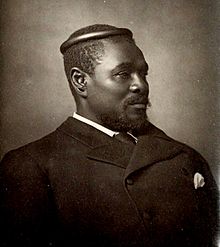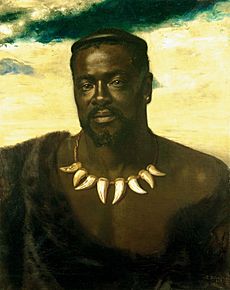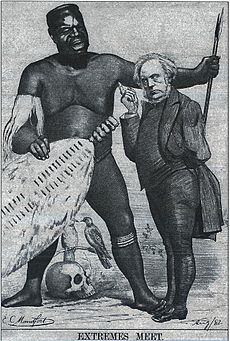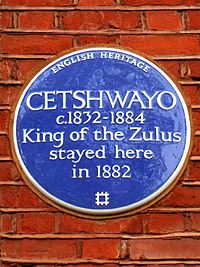Cetshwayo facts for kids
Quick facts for kids Cetshwayo kaMpande |
|||||
|---|---|---|---|---|---|
| King of the Zulu Kingdom | |||||

Photograph of Cetshwayo by Alexander Bassano in Old Bond Street, London
|
|||||
| Predecessor | Mpande | ||||
| Successor | Dinuzulu | ||||
| Born | c. 1826 Eshowe, Zulu Kingdom |
||||
| Died | 8 February 1884 (aged 57–58) Eshowe, Zulu Kingdom |
||||
| Issue | Dinuzulu | ||||
|
|||||
| House | House of Zulu | ||||
| Father | Mpande | ||||
| Mother | Ngqumbazi | ||||
Cetshwayo kaMpande (/kɛtʃˈwaɪ.oʊ/; Zulu pronunciation: [ǀétʃwajo kámpande]; c. 1826 – 8 February 1884) was a powerful king of the Zulu Kingdom. He ruled from 1873 to 1879. He was also the leader of the Zulu army during the Anglo-Zulu War of 1879. Cetshwayo tried to avoid war and sought peace with the British. However, he was defeated and sent away after the war. He later returned to Zululand and died in 1884. His name can be spelled in different ways, like Cetawayo or Ketchwayo.
Contents
King Cetshwayo: A Zulu Leader
Early Life and Rise to Power
Cetshwayo was the son of Zulu King Mpande and Queen Ngqumbazi. He was also the half-nephew of the famous Zulu King Shaka. In 1856, Cetshwayo won a big battle against his younger brother Mbuyazi. This battle was called the Battle of Ndondakusuka. After this victory, Cetshwayo became the main leader of the Zulu people. He was not officially king yet because his father was still alive. People at the time said he was very tall, about 6 feet 6 inches to 6 feet 8 inches. He was also said to be very strong.
Cetshwayo had another half-brother, Umthonga, who was a possible rival. Umthonga ran away to the Boers (Dutch settlers) several times. This made Cetshwayo worry that Umthonga might get help from the Boers against him. Cetshwayo also had a half-brother named uHamu kaNzibe. Hamu sometimes went against the Zulu cause.
Becoming King of the Zulus
King Mpande passed away in 1872. His death was kept secret for a short time to make sure Cetshwayo could become king smoothly. Cetshwayo was officially made king on September 1, 1873. Sir Theophilus Shepstone, a British official, crowned Cetshwayo.
Cetshwayo then created a new capital city for the Zulu nation. He named it Ulundi, which means "the high place." He made his army stronger and brought back some of the fighting methods used by King Shaka. He also gave his soldiers (called impis) muskets, which are old types of guns. Cetshwayo also asked European missionaries to leave his land.
The Anglo-Zulu War
Causes of the Conflict
In 1878, a British official named Sir Henry Bartle Frere wanted to unite the British colonies in South Africa. He felt that a strong Zulu kingdom next door made this difficult. Frere started to demand things from Cetshwayo. He complained about Zulu border issues and Cetshwayo's policies. He wanted to make the Zulu king angry.
Cetshwayo tried to stay calm. He thought the British were his friends. He knew the British Army was very powerful. Cetshwayo said that he and Frere were equals. He felt that just as he didn't complain about Frere's rule, Frere should not complain about Zululand.
The Ultimatum and First Battles
Eventually, Frere gave Cetshwayo an ultimatum. This was a final demand that Cetshwayo had to obey. The ultimatum demanded that Cetshwayo break up his army. Cetshwayo refused this demand, which led to war in 1879. Even after the war started, Cetshwayo kept trying to make peace.
The first major battle was the Battle of Isandlwana. The Zulus won this battle, but it was a very costly victory for them. The British suffered other defeats at the Battle of Intombe and the Battle of Hlobane. However, the British won important battles at Rorke's Drift and Kambula. These victories stopped the British army from completely falling apart.
Peace Efforts and Defeat
After the British retreated, the Zulus could have attacked deeper into Natal. But Cetshwayo did not order such an attack. He wanted to push back the British and then make a peace treaty. However, his translator, Cornelius Vijn, warned the British about Zulu forces gathering during these peace talks.
The British then returned to Zululand with a much larger and better-armed force. They finally captured the Zulu capital at the Battle of Ulundi. In this battle, the British used cannons and Gatling guns. They formed a strong square formation on an open plain. The battle lasted about 45 minutes. The British cavalry then charged, causing the Zulus to scatter.
After Ulundi was captured and burned on July 4, Cetshwayo was removed from power. He was sent away, first to Cape Town, and then to London. He returned to Zululand in 1883.
Support for Cetshwayo
From 1881, many people supported Cetshwayo. One important supporter was Lady Florence Dixie, a newspaper writer. She wrote articles and books to help him. Cetshwayo's calm and polite manner also gained him public sympathy. Many people felt he had been treated unfairly by the British officials.
Later Life and Legacy
By 1882, there were disagreements between two Zulu groups. One group supported Cetshwayo (called uSuthus). The other group was led by three rival chiefs, especially Zibhebhu. These disagreements led to a civil war.
In 1883, the British government tried to let Cetshwayo rule part of his old territory again. But this attempt did not work. Chief Zibhebhu, with the help of Boer soldiers, started a war over who would be the next king. On July 22, 1883, Zibhebhu attacked Cetshwayo's new home in Ulundi. Cetshwayo was hurt but escaped to a forest.
After being asked by a British official, Cetshwayo moved to Eshowe. He died there a few months later on February 8, 1884. He was about 57–60 years old. People believe he died from a heart attack, but some think he might have been poisoned. His body was buried in a field near the forest. The remains of the wagon that carried his body to the grave can be seen at Ondini Museum.
Cetshwayo is remembered as the last king of the independent Zulu Kingdom. His son Dinuzulu became king on May 20, 1884. A special plaque in London marks where Cetshwayo stayed in 1882.
Legacy
In 2016, a district in South Africa was named after him. It is called the King Cetshwayo District Municipality.
See also
 In Spanish: Cetshwayo para niños
In Spanish: Cetshwayo para niños






